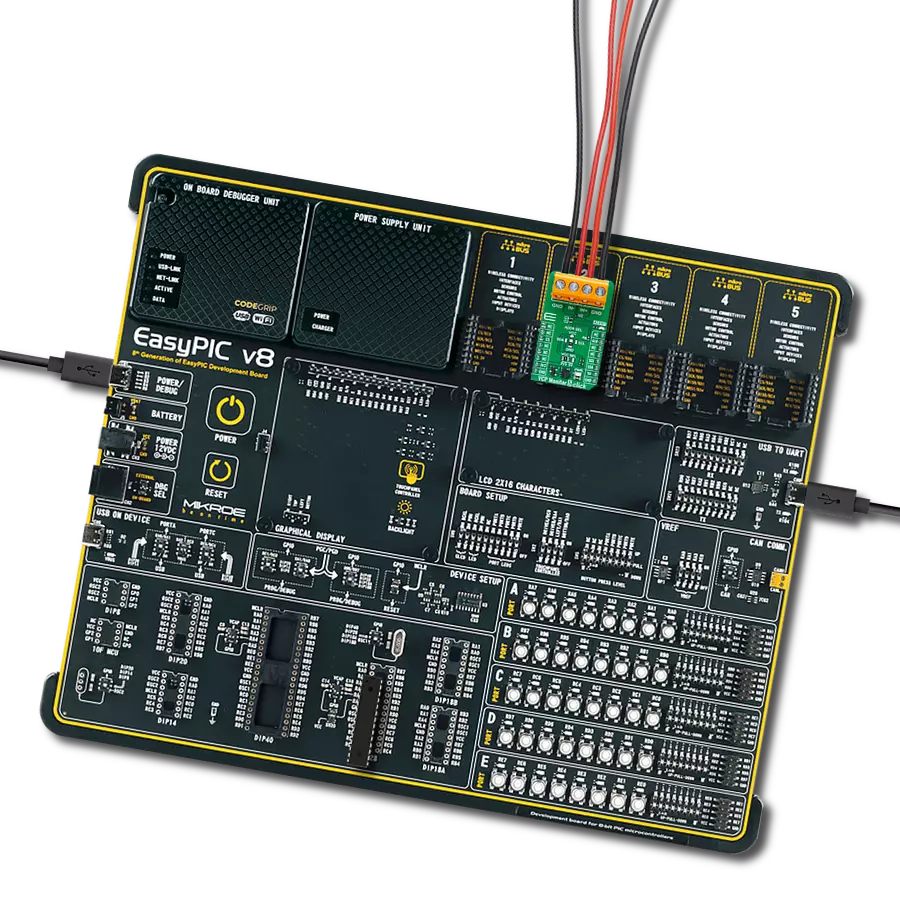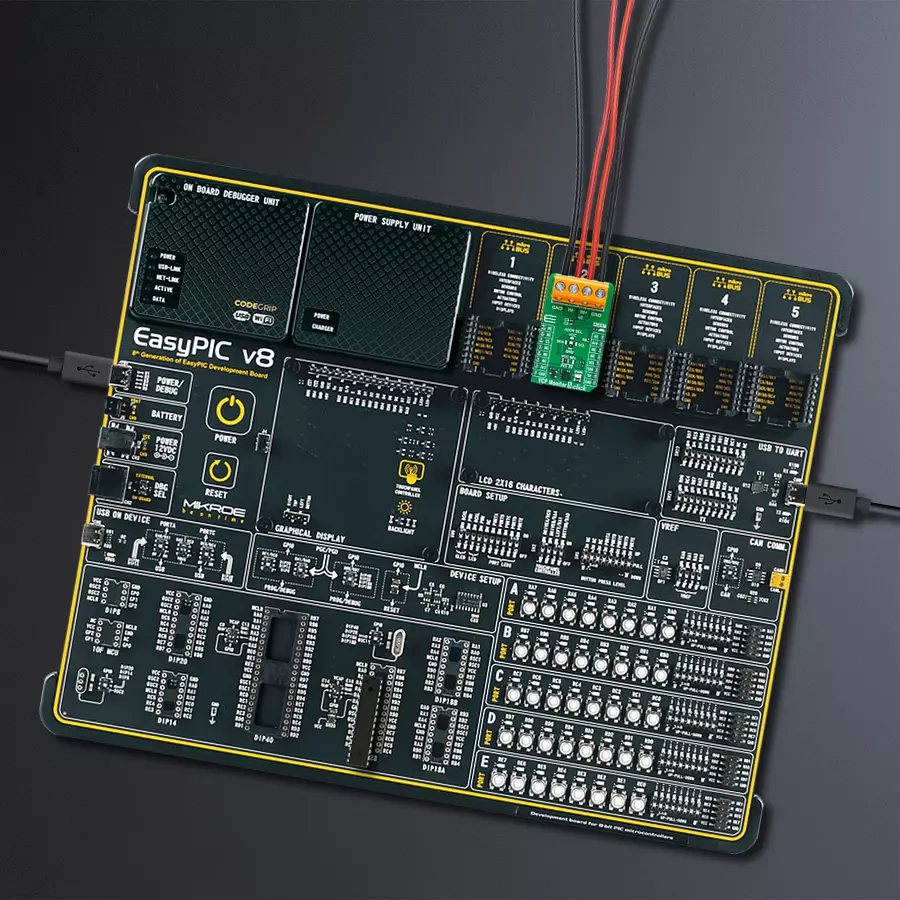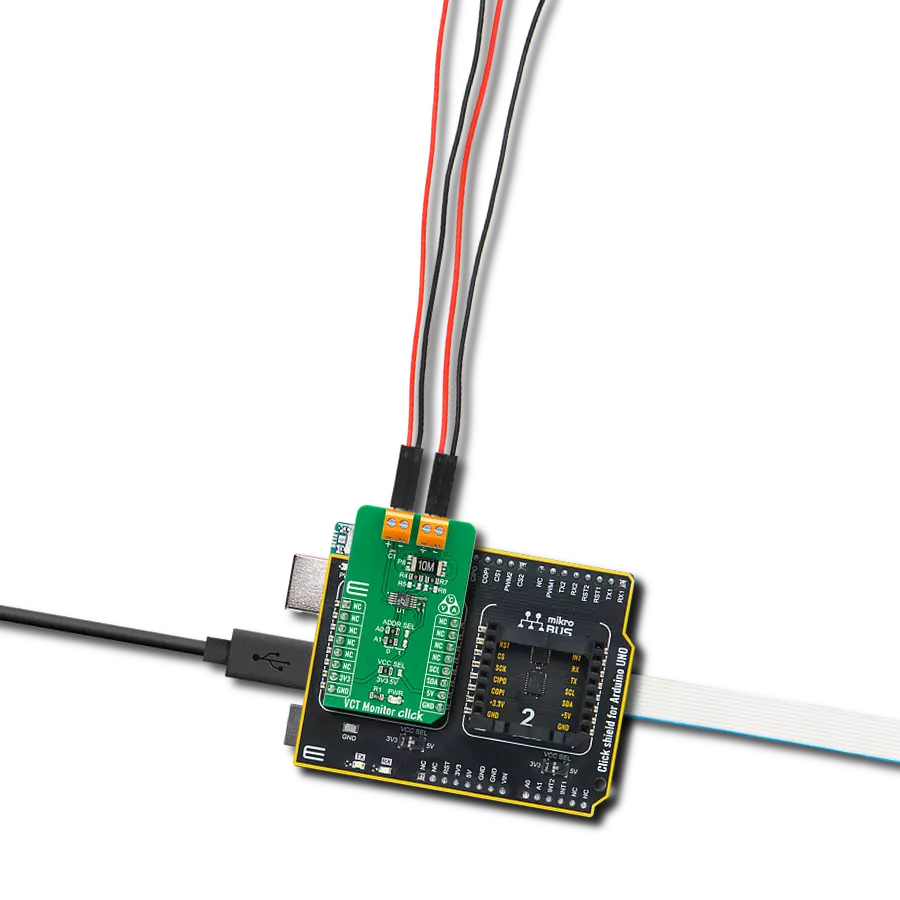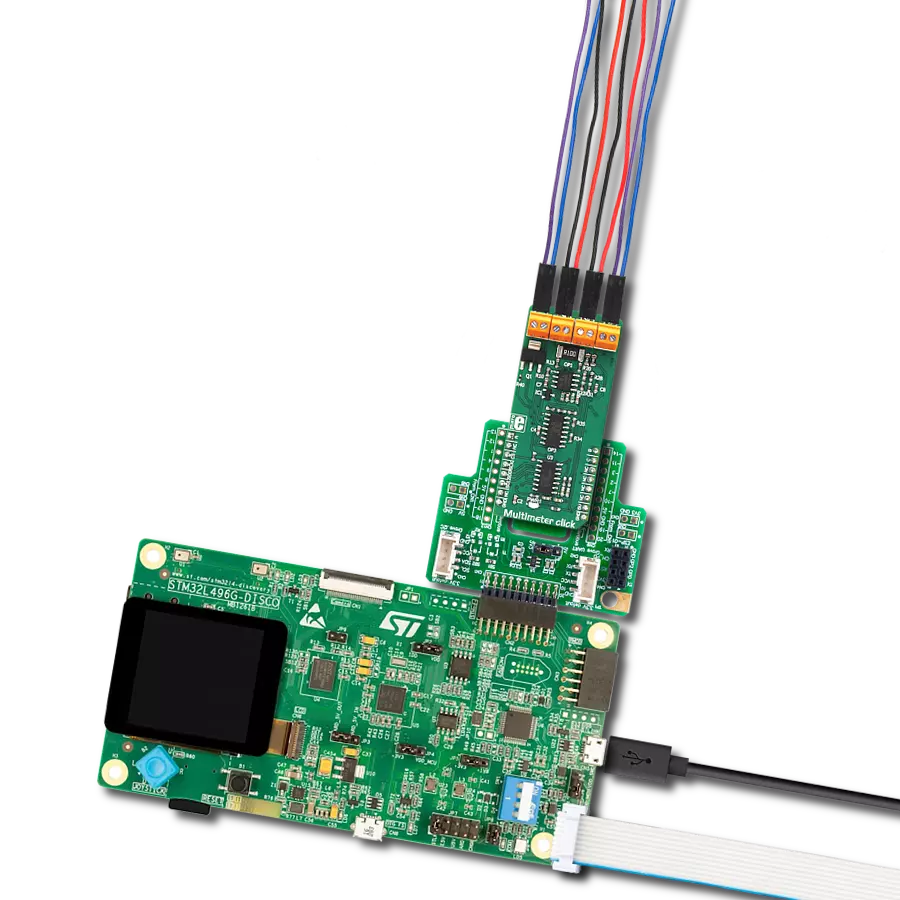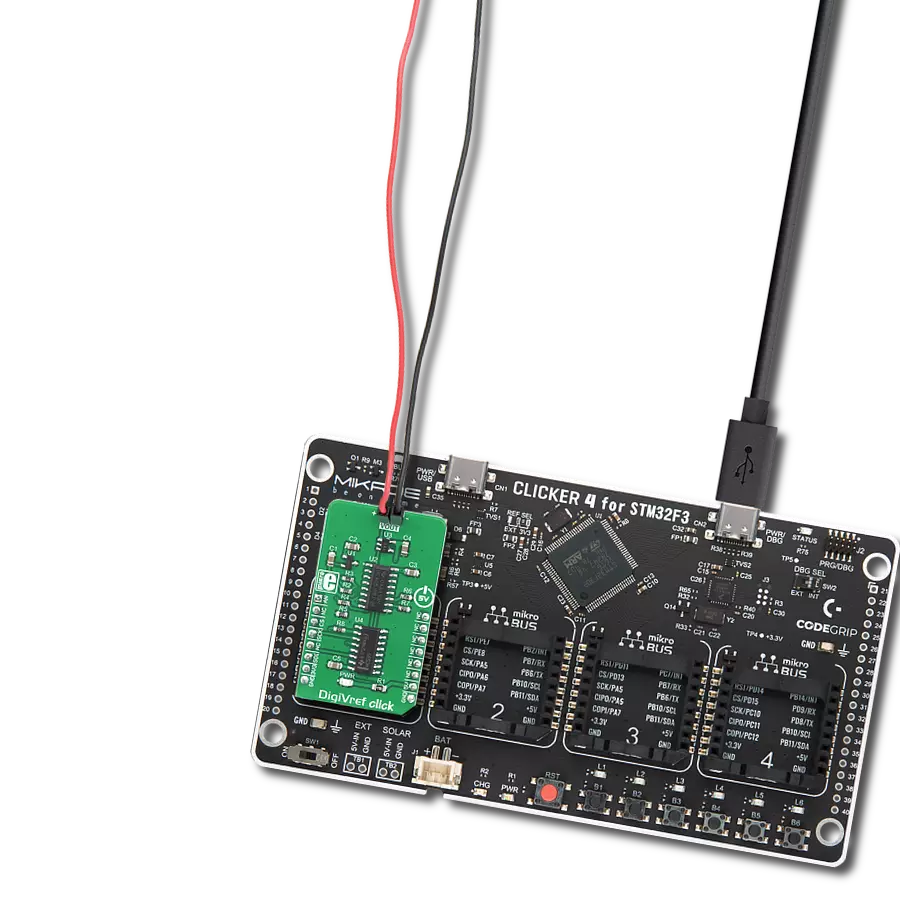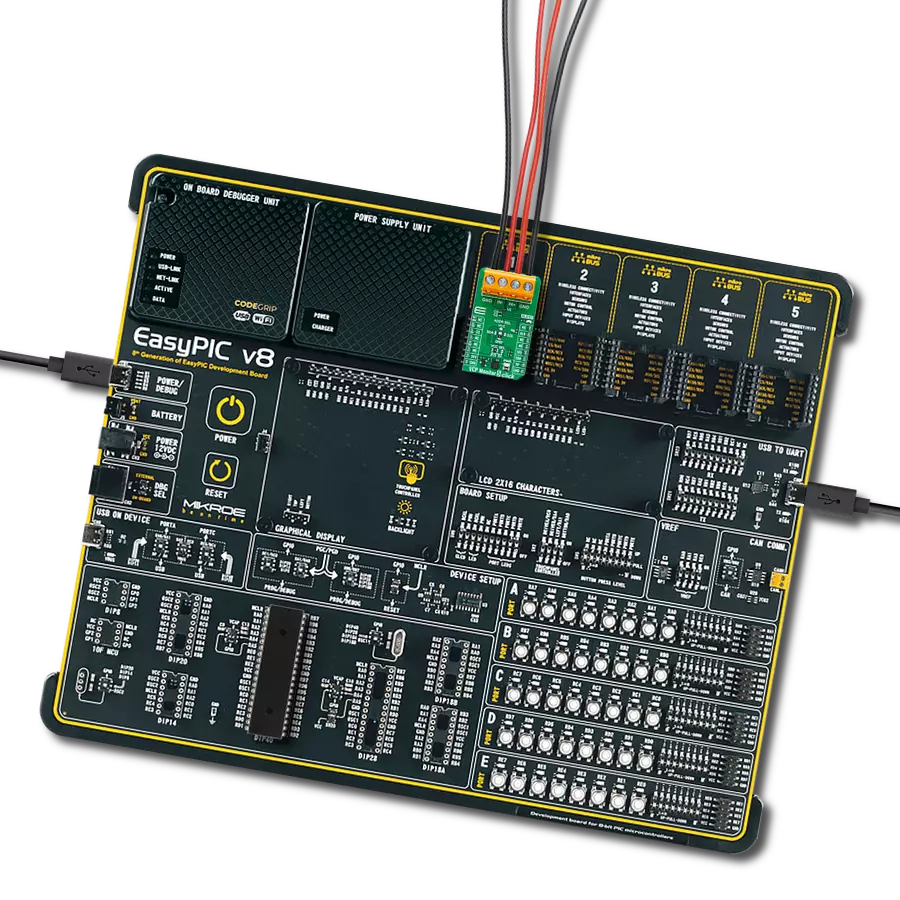监控电流、电压和温度,具有高精度,以实现精确的能量管理
A
A
硬件概览
它是如何工作的?
VCP Monitor 5 Click 基于 Texas Instruments 的 INA700A,这是一款采用先进的 EZShunt™ 技术的 16 位数字功率监测器。INA700A 集成了精密分流电阻和高分辨率的 ΔΣ ADC,专为精确电流检测应用设计。此 IC 可处理高达 ±15.728A 的满量程电流测量,工作在 -0.3V 到 +40V 的宽泛共模电压范围内,适用于多种功率监测需求。它非常适合高精度功率监控应用,包括工业电池组、智能网络接口卡 (NIC) 和硬件加速卡等高性能系统,这些系统需要精确的电流和能量监测。此功率监测器能够精确测量和报告电流、总
线电压、内部温度、功率、能量和电荷积累。凭借内置的 ±0.5% 振荡器,它可以在后台无缝执行实时计算。集成的温度传感器在结温范围内的精度为 ±3°C,确保在各种操作条件下实现可靠的热监测。设备支持从 50µs 到 4.12ms 的可选 ADC 转换时间,并提供 1x 到 1024x 的采样平均选项,大幅降低测量噪声并提高过流事件检测窗口的精确度。VCP Monitor 5 Click 使用标准的 2 线 I2C 通信协议,使主 MCU 可以控制 INA700A。I2C 接口支持高达 400kHz 的时钟频率,可通过 ADDR SEL 跳线选择 I2C 地址。警报
中断 ALR 引脚可用于在监测输出值超出范围阈值时报告多个诊断,或在 ADC 转换完成时提供指示。检测到的异常情况(如电流欠/超限、总线电压欠/超限或功率超限)除了通过 ALR 引脚,还可以通过红色 ALERT LED 进行可视化显示。此 Click 板™ 可以使用 3.3V 或 5V 的逻辑电压水平,通过 VCC SEL 跳线选择,从而使 3.3V 和 5V 的 MCU 都能正确使用通信线路。此外,此 Click 板™ 附带易于使用的函数库和示例代码,可用作进一步开发的参考。
功能概述
开发板
EasyPIC v8 是一款专为快速开发嵌入式应用的需求而特别设计的开发板。它支持许多高引脚计数的8位PIC微控制器,来自Microchip,无论它们的引脚数量如何,并且具有一系列独特功能,例如首次集成的调试器/程序员。开发板布局合理,设计周到,使得最终用户可以在一个地方找到所有必要的元素,如开关、按钮、指示灯、连接器等。得益于创新的制造技术,EasyPIC v8 提供了流畅而沉浸式的工作体验,允许在任何情况下、任何地方、任何时候都能访问。
EasyPIC v8 开发板的每个部分都包含了使同一板块运行最高效的必要组件。除了先进的集成CODEGRIP程 序/调试模块,该模块提供许多有价值的编程/调试选项和与Mikroe软件环境的无缝集成外,该板还包括一个干净且调节过的开发板电源供应模块。它可以使用广泛的外部电源,包括电池、外部12V电源供应和通过USB Type-C(USB-C)连接器的电源。通信选项如USB-UART、USB DEVICE和CAN也包括在内,包括 广受好评的mikroBUS™标准、两种显示选项(图形和
基于字符的LCD)和几种不同的DIP插座。这些插座覆盖了从最小的只有八个至四十个引脚的8位PIC MCU的广泛范围。EasyPIC v8 是Mikroe快速开发生态系统的一个组成部分。它由Mikroe软件工具原生支持,得益于大量不同的Click板™(超过一千块板),其数量每天都在增长,它涵盖了原型制作和开发的许多方面。
微控制器概述
MCU卡片 / MCU
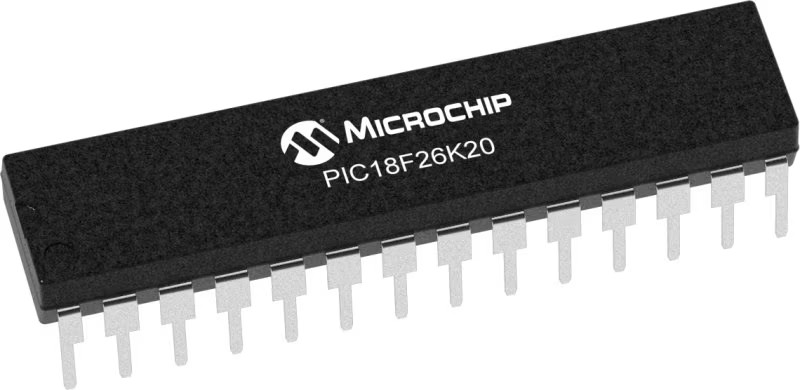
建筑
PIC
MCU 内存 (KB)
64
硅供应商
Microchip
引脚数
28
RAM (字节)
3936
使用的MCU引脚
mikroBUS™映射器
“仔细看看!”
Click board™ 原理图

一步一步来
项目组装
实时跟踪您的结果
应用程序输出
1. 应用程序输出 - 在调试模式下,“应用程序输出”窗口支持实时数据监控,直接提供执行结果的可视化。请按照提供的教程正确配置环境,以确保数据正确显示。

2. UART 终端 - 使用UART Terminal通过USB to UART converter监视数据传输,实现Click board™与开发系统之间的直接通信。请根据项目需求配置波特率和其他串行设置,以确保正常运行。有关分步设置说明,请参考提供的教程。

3. Plot 输出 - Plot功能提供了一种强大的方式来可视化实时传感器数据,使趋势分析、调试和多个数据点的对比变得更加直观。要正确设置,请按照提供的教程,其中包含使用Plot功能显示Click board™读数的分步示例。在代码中使用Plot功能时,请使用以下函数:plot(insert_graph_name, variable_name);。这是一个通用格式,用户需要将“insert_graph_name”替换为实际图表名称,并将“variable_name”替换为要显示的参数。

软件支持
库描述
该库包含 VCP Monitor 5 Click 驱动程序的 API。
关键功能:
vcpmonitor5_get_bus_voltage- 此函数通过 I2C 串行接口读取总线电压输出测量值,单位为伏特 [V]。vcpmonitor5_get_current- 此函数通过 I2C 串行接口读取电流测量结果,单位为毫安 [mA]。vcpmonitor5_get_power- 此函数通过 I2C 串行接口读取功率测量结果,单位为瓦特 [W]
开源
代码示例
完整的应用程序代码和一个现成的项目可以通过NECTO Studio包管理器直接安装到NECTO Studio。 应用程序代码也可以在MIKROE的GitHub账户中找到。
/*!
* @file main.c
* @brief VCP Monitor 5 Click example
*
* # Description
* This library contains API for the VCP Monitor 5 Click driver
* for measurements of the voltage, current, power, energy, charge, and die temperature.
*
* The demo application is composed of two sections :
*
* ## Application Init
* The initialization of the I2C module and log UART.
* After driver initialization, the app sets the default configuration.
*
* ## Application Task
* The demo application reads and displays the results of the input bus voltage,
* current, power, energy, charge accumulation measurements, and die temperature.
* Results are being sent to the UART Terminal, where you can track their changes.
*
* @author Nenad Filipovic
*
*/
#include "board.h"
#include "log.h"
#include "vcpmonitor5.h"
static vcpmonitor5_t vcpmonitor5;
static log_t logger;
void application_init ( void )
{
log_cfg_t log_cfg; /**< Logger config object. */
vcpmonitor5_cfg_t vcpmonitor5_cfg; /**< Click config object. */
/**
* Logger initialization.
* Default baud rate: 115200
* Default log level: LOG_LEVEL_DEBUG
* @note If USB_UART_RX and USB_UART_TX
* are defined as HAL_PIN_NC, you will
* need to define them manually for log to work.
* See @b LOG_MAP_USB_UART macro definition for detailed explanation.
*/
LOG_MAP_USB_UART( log_cfg );
log_init( &logger, &log_cfg );
log_info( &logger, " Application Init " );
// Click initialization.
vcpmonitor5_cfg_setup( &vcpmonitor5_cfg );
VCPMONITOR5_MAP_MIKROBUS( vcpmonitor5_cfg, MIKROBUS_1 );
if ( I2C_MASTER_ERROR == vcpmonitor5_init( &vcpmonitor5, &vcpmonitor5_cfg ) )
{
log_error( &logger, " Communication init." );
for ( ; ; );
}
if ( VCPMONITOR5_ERROR == vcpmonitor5_default_cfg ( &vcpmonitor5 ) )
{
log_error( &logger, " Default configuration." );
for ( ; ; );
}
log_info( &logger, " Application Task " );
}
void application_task ( void )
{
float app_buf = 0;
if ( VCPMONITOR5_OK == vcpmonitor5_get_bus_voltage( &vcpmonitor5, &app_buf ) )
{
log_printf( &logger, " Voltage: %.2f [V]\r\n", app_buf );
Delay_ms ( 50 );
}
if ( VCPMONITOR5_OK == vcpmonitor5_get_current( &vcpmonitor5, &app_buf ) )
{
log_printf( &logger, " Current: %.2f [mA]\r\n", app_buf );
Delay_ms ( 50 );
}
if ( VCPMONITOR5_OK == vcpmonitor5_get_power( &vcpmonitor5, &app_buf ) )
{
log_printf( &logger, " Power: %.2f [W]\r\n", app_buf );
Delay_ms ( 50 );
}
if ( VCPMONITOR5_OK == vcpmonitor5_get_energy( &vcpmonitor5, &app_buf ) )
{
log_printf( &logger, " Energy: %.2f [kJ]\r\n", app_buf );
Delay_ms ( 50 );
}
if ( VCPMONITOR5_OK == vcpmonitor5_get_charge( &vcpmonitor5, &app_buf ) )
{
log_printf( &logger, " Charge: %.2f [C]\r\n", app_buf );
Delay_ms ( 50 );
}
if ( VCPMONITOR5_OK == vcpmonitor5_get_temperature( &vcpmonitor5, &app_buf ) )
{
log_printf( &logger, " Temperature: %.2f [degC]\r\n", app_buf );
Delay_ms ( 50 );
}
log_printf( &logger, " ----------------------------\r\n" );
Delay_ms ( 1000 );
Delay_ms ( 1000 );
}
int main ( void )
{
/* Do not remove this line or clock might not be set correctly. */
#ifdef PREINIT_SUPPORTED
preinit();
#endif
application_init( );
for ( ; ; )
{
application_task( );
}
return 0;
}
// ------------------------------------------------------------------------ END
